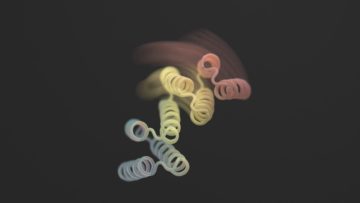Shelly Fan in Singularity Hub:
 We often think of proteins as immutable 3D sculptures. That’s not quite right. Many proteins are transformers that twist and change their shapes depending on biological needs. One configuration may propagate damaging signals from a stroke or heart attack. Another may block the resulting molecular cascade and limit harm.
We often think of proteins as immutable 3D sculptures. That’s not quite right. Many proteins are transformers that twist and change their shapes depending on biological needs. One configuration may propagate damaging signals from a stroke or heart attack. Another may block the resulting molecular cascade and limit harm.
In a way, proteins act like biological transistors—on-off switches at the root of the body’s molecular “computer” determining how it reacts to external and internal forces and feedback. Scientists have long studied these shape-shifting proteins to decipher how our bodies function. But why rely on nature alone? Can we create biological “transistors,” unknown to the biological universe, from scratch? Enter AI. Multiple deep learning methods can already accurately predict protein structures—a breakthrough half a century in the making. Subsequent studies using increasingly powerful algorithms have hallucinated protein structures untethered by the forces of evolution. Yet these AI-generated structures have a downfall: although highly intricate, most are completely static—essentially, a sort of digital protein sculpture frozen in time.
A new study in Science this month broke the mold by adding flexibility to designer proteins. The new structures aren’t contortionists without limits. However, the designer proteins can stabilize into two different forms—think a hinge in either an open or closed configuration—depending on an external biological “lock.” Each state is analogous to a computer’s “0” or “1,” which subsequently controls the cell’s output. “Before, we could only create proteins that had one stable configuration,” said study author Dr. Florian Praetorius at the University of Washington. “Now, we can finally create proteins that move, which should open up an extraordinary range of applications.” Lead author Dr. David Baker has ideas: “From forming nanostructures that respond to chemicals in the environment to applications in drug delivery, we’re just starting to tap into their potential.”
More here.
